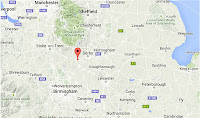The British Geological Survey has recorded
a series of Earthquakes in northern Nottingham, England. The first event occurred slightly before 9.25 am GMT on Thursday 18 November 2015 about 7 k to the south of Worksop, and had a Magnitude of 1.7 and a depth of 2 km. The second event happened slightly after 10.30 GMT on the same day, and also had a Magnitude of 1.7, occurring at a depth of 4 km about 10 km to the southwest of Worksop. The third event happened slightly after 1.20 am GMT on Friday 20 November, again about 10 km to the southeast of Worksop, this time having a Magnitude of 1.4 and a depth of 2 km. The final incident (to date) occurred slightly before 1.30 am on the same day, again about 10 km to the southwest of Nottingham, and having a Magnitude of 1.2 and a dept of 3 km. None of these incident is large enough to have caused any damage or injuries, but they may have been felt locally.
The approximate location of the 19-20 November 2015 Nottinghamshire Earthquakes. Google Maps.
Earthquakes become more common as you travel north and west in Great Britain, with the west coast of Scotland being the most quake-prone part of the island and the northwest of Wales being more prone to quakes than the rest of Wales or most of England. However, while quakes in southern England are less frequent, they are often larger than events in the north, as tectonic presures tend to build up for longer periods of time between events, so that when they occur more pressure is released.
The
precise cause of Earthquakes in the UK can be hard to determine; the
country is not close to any obvious single cause of such activity such
as a plate margin, but is subject to tectonic pressures from several
different sources, with most quakes probably being the result of the
interplay between these forces.
Britain
is being pushed to the east by the expansion of the Atlantic Ocean and
to the north by the impact of Africa into Europe from the south. It is
also affected by lesser areas of tectonic spreading beneath the North
Sea, Rhine Valley and Bay of Biscay. Finally the country is subject to
glacial rebound; until about 10 000 years ago much of the north of the
country was covered by a thick layer of glacial ice (this is believed to
have been thickest on the west coast of Scotland), pushing the rocks of
the British lithosphere down into the underlying mantle. This ice is
now gone, and the rocks are springing (slowly) back into their original
position, causing the occasional Earthquake in the process.
(Top) Simplified diagram showing principle of glacial rebound. Wikipedia.
(Bottom) Map showing the rate of glacial rebound in various parts of
the UK. Note that some parts of England and Wales show negative values,
these areas are being pushed down slightly by uplift in Scotland, as the
entire landmass is quite rigid and acts a bit like a see-saw. Climate North East.
A series of Earthquakes around Ollerton in Nottinghamshire (about 10 km to the east of the November 2015 Earthquakes) in 2013-14 has been linked to the area's coal mining industry, as has a larger series of Earthquakes around Stoke-on-Trent in north Staffordshire in the mid 1970s. Mining can occasionally trigger Earthquakes as most Earthquakes occur along pre-existing faults in areas of tectonic stress, When mining occurs close to such a fault it can alter the stress states in the rocks close to the fault, triggering further movement, sometimes even after the mining activity has ceased.
Epicentres of earthquake activity around New Ollerton. The yellow
circles show events since December 2013. The red circles show historical
earthquake activity. British Geological Survey.
Whilst sometimes alarming, mining-induced Earthquakes are not thought to present a major hazard in the UK. The largest of the Ollerton Earthquakes had a Magnitude of 1.8, while the largest recorded Earthquakes thought to have been triggered by mining in the UK have only had Magnitudes of about 3.0, not large enough to cause serious structural damage to buildings, even when they occur at shallow depths, though there have been some reports of superficial damage (cracked plaster etc.) caused by mining-induced Earthquakes in the UK.
Mining Seismicity in the UK (red circles) alongside natural background earthquake activity (open circles). British Geological Survey.
Witness accounts of Earthquakes can help geologists to understand these events, and the structures that cause them. If you felt any of these quakes, or were in the area but did not (which is also useful information) then you can report it to the British Geological Survey here.
See also...
 Magnitude 1.4 Earthquake in Staffordshire, England. The British Geological Survey recorded
a Magnitude 1.4 Earthquake at a depth of 10 km about 10 km to the west
of the city of Stoke-on-Trent in Staffordshore...
Magnitude 1.4 Earthquake in Staffordshire, England. The British Geological Survey recorded
a Magnitude 1.4 Earthquake at a depth of 10 km about 10 km to the west
of the city of Stoke-on-Trent in Staffordshore...
The British Geological Survey recorded
a Magnitude 1.8 Earthquake at a depth of 1 km about 1 km to the east of
the town of Chapel-en-le-Frith in the Peak District...
 Magnitude 1.1 Earthquake in south Derbyshire, England.
The British Geological Survey recorded a Magnitude 1.1 Earthquake at a depth of 7 km between the villages of Sutton on the Hill and Marston on Dove in..
Magnitude 1.1 Earthquake in south Derbyshire, England.
The British Geological Survey recorded a Magnitude 1.1 Earthquake at a depth of 7 km between the villages of Sutton on the Hill and Marston on Dove in..
Follow Sciency Thoughts on Facebook.






